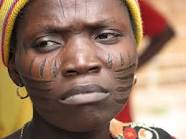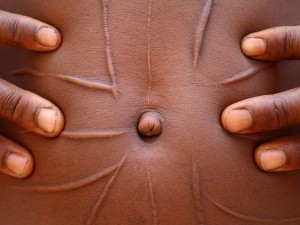Tribal marks in Africa are scarification’s used for identification and beautification. The mark is inscribed mostly on the face and on other parts of the body. Modern Africans do not carry the same ideology as their forefathers. They believe tribal marks are a violation of children’s rights and can expose them to diseases such as HIV, hepatitis and other diseases transferred by blood. Reports carried out on people with tribal marks show that they are constantly subjected to embarrassment, rejection and low self-esteem unlike their forefathers who value the marks as a means of belonging, respect and Power.
At present, tribal marks are becoming a thing of the past in almost all African countries; reasons being that, the call for the abolishment of tribal marks over the years has generated attention locally and internationally. Campaigners have been able to get the support of most African governments to enact a law to protect children against this tradition. Africans are naturally beautiful and endowed, their beauty, respect and identity should not be linked to these marks but rather to self-awareness, self-belonging and self-values. Non Africans without the knowledge and understanding of tribal marks often think that people with the mark might have been in a fight with a lion or tiger.
The history of tribal mark in Yoruba West Africa Nigeria
Tribal marks are practised on boys and girls in all tribes in all African countries. For some tribes, it is a ritual to mark the transition from childhood to boyhood. Before the 19th century, most tribes used tribal marks to identify enemies during tribal wars, and the Yoruba tribe from Nigeria have a strong belief to this day that tribal marks can help to keep mischievous children alive known as Abiku (children with unclean spirits such as water, forest etc.). Tribes from different ethnic groups have a specific reason for adopting tribal marks. The marks also differ in pattern, size, length and shape and the part of the body where the tribal mark is in-scripted also depends on tribes and culture.
The history of tribal marks can also be traced to the era of slavery and colonization where colonial masters are known to have captured and transported Africans to foreign countries as slaves. Leaders of most communities started giving their community members tribal marks as a way of identification whenever they are found or freed. Evidence suggests that this really worked! After the abolishment of slave trade, it was believed that some repatriated slaves were able to trace their families though their marks.
A story of a king from the Yoruba lineage is often used to establish the history of tribal marks in Nigeria. The famous king is called Sango, and it was documented that he sent two of his slaves on an important mission. One of the slaves did well but Sango got so angry with the other one that he handed him over to his guards and asked them to give him twenty two razor cuts all over his body. The cuts were severe but when the scars healed the king’s wives fancied the new appearance of the slave. Therefore, the king decided to have razor cuts inflicted on himself, but he couldn’t take more than two cuts. Consequently, the king decided that cuts should no longer be given as punishment but as a sign of royalty, beautification and identification.
Tribal marks are no doubt part of Africa heritage and culture but it has rapidly faded out. Presently, it’s hard to see Africans under the age of 35 with tribal marks. Personally it feels so good to see this transition! Tribal marks have a long history in African tradition and culture but most Africans today believe the practise is a violation of human rights and should be stopped.
“Traditions and culture should be preserved and respected but those at the detriment of human health and safety should be abolished”

